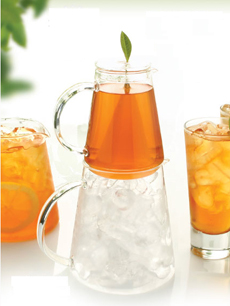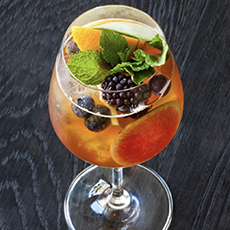Iced Tea History, Facts & Trivia For National Iced Tea Month
|
|
June is National Iced Tea Month; June 10th is National Iced Tea Day. Eighty percent of the tea drunk in the U.S. is bottled tea, meant to be served cold. Who invented iced tea? It’s possible that centuries ago, some wealthy* person (or servant) in the tea-growing nations of Ceylon, China, India or Japan may have taken some ice from the ice-house to cool down a cup of hot tea on a warm day. If it ever happened, the practice didn’t take hold, and no old recipes exist for it. > The different types of tea: a photo glossary. ________________ *Before refrigeration, only the wealthy could afford to have ice cut from lakes and rivers in the winter and stored in ice houses for summer use. The oldest known ice house, built by a king in Persia, dates from about 1700 B.C.E. Most other people dug ice pits, lined with straw and sawdust. While commercial refrigeration was available by the late 1800s, the home refrigerator didn’t arrive until 1930. Prior to then, people used an insulated metal “ice box,” which held ice delivered from the “ice man” to keep perishables cold. When the ice melted, it was replaced. We don’t know who made the first iced tea, but we can approximate when it happened. The oldest known recipe for “sweet ice tea” (with lots of sugar) was published in 1879, in a community cookbook called “Housekeeping in Old Virginia” by Marion Cabell Tyree. The recipe calls for green tea, which was popular in the Colonies (Benjamin Franklin mentions it in his autobiography) before falling out of favor—likely because milk and sugar, the popular accompaniments, taste better in black tea. There’s also a newspaper clipping recounting the menu served at the 1890 Missouri State Reunion of Ex-Confederate Veterans, which included iced tea. What you’ll most likely find in books and online is that iced tea was inadvertently “invented” in St. Louis at the 1904 Louisiana Purchase Exposition (often called the 1904 World’s Fair, but that term was not yet in use). |
|
|
As the story goes, Richard Blechynden, a tea merchant, was having limited success getting people to taste his hot tea in the intense summer heat and humidity of St. Louis. He had the idea to add ice into the tea, thus creating a refreshing, cool drink. Blechynden is sometimes referred to as a tea plantation owner, but in fact, he was an Englishman employed as the India Tea Commissioner. He headed an initiative, begun in 1896, to publicize the black teas of India and Ceylon (modern day Sri Lanka) to Americans. According to TeaUSA.org, Blechynden and his tea samples were in the elaborately designed India pavilion. When he realized that it was too hot to get the crowds to taste free samples of his hot tea, Blechynden and his team did something ingenious. They didn’t toss ice into the tea, as is commonly written. Instead, they created a cooling apparatus, filling several large bottles with brewed tea and placing the bottles upside-down on a stand that allowed the tea to flow through iced lead pipes, emerging chilled. The “iced” tea was a hit at the fair, and a real boon to India tea awareness. After the fair, Blechynden took the lead pipe apparatus to New York City, offering free iced tea to shoppers at Bloomingdale Brothers’ department store. Word spread, and iced black tea became a popular summertime drink. It led to recipes for tea punch, which included simple syrup, fruit juices (cherry, grape, lemon, orange and/or pineapple), lemon and/or orange slices, maraschino cherries, fresh mint and canned or preserved fruits. Blechynden’s efforts also raised the popularity of black tea as a hot drink. Interest in green tea faded—except to those who visited Japanese restaurants beginning around 1970—until the health-conscious 1990s. CHECK OUT WHAT’S HAPPENING ON OUR HOME PAGE, THENIBBLE.COM. |
||





